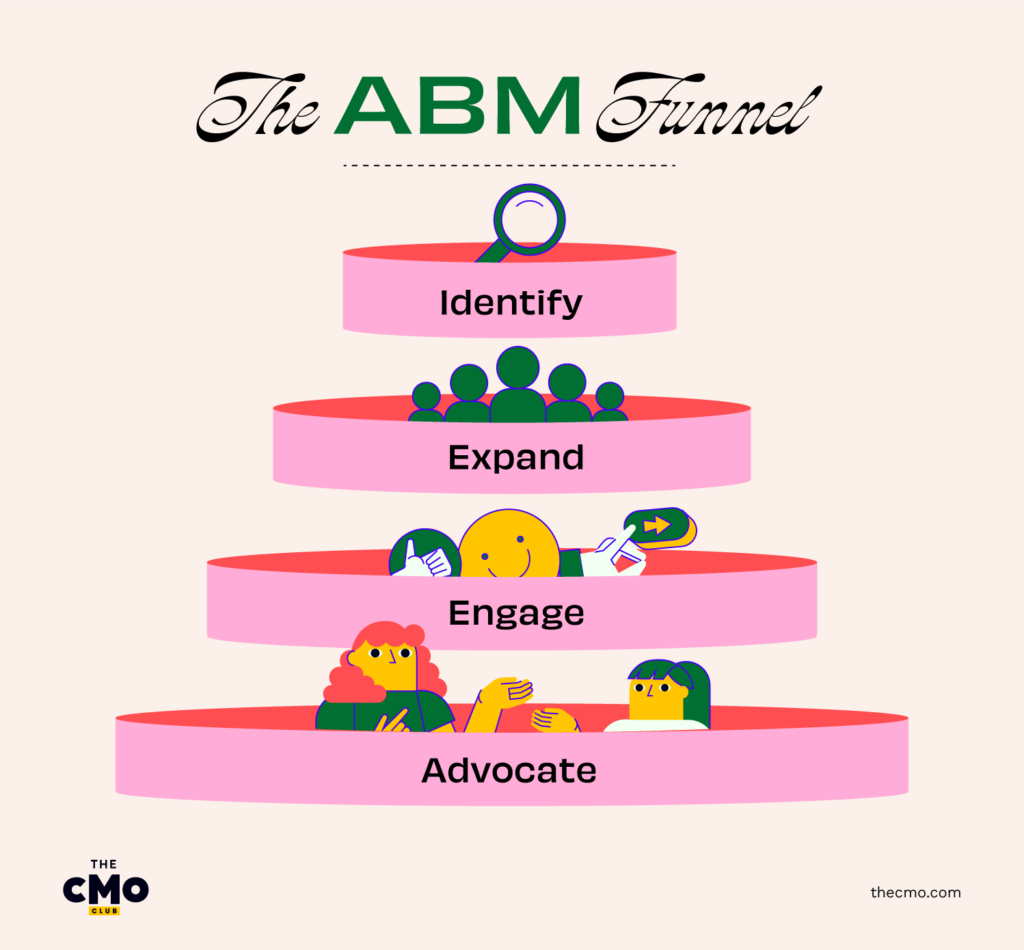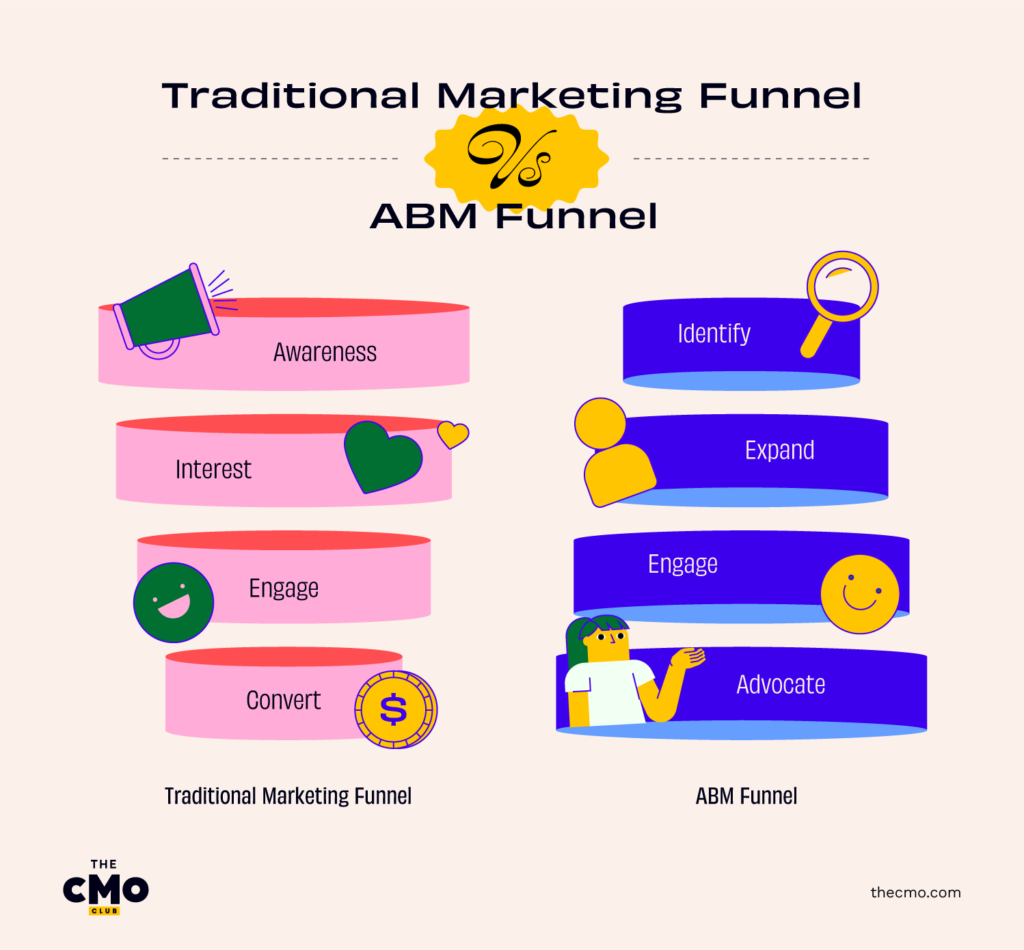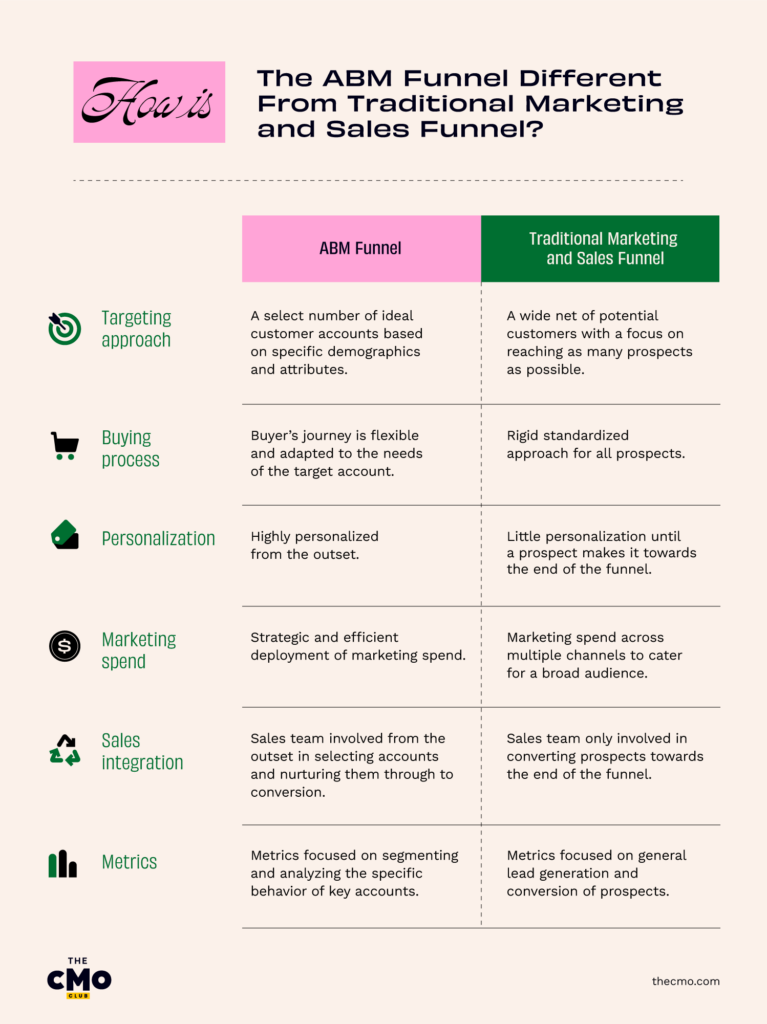Account-based marketing (ABM) is a powerful way to secure high-value clients. So much so that according to the Sirius Decisions Account-Based Marketing Guide, 73% of marketers reported seeing larger average deal sizes with account-based marketing accounts. At the crux of this particular marketing strategy is the ABM funnel, but how does it work?
In this guide, I explore the differences between the ABM funnel and traditional marketing funnel, and how to create an ABM funnel that delivers results.
What is an Account-Based Marketing Funnel?
An account-based marketing funnel turns the traditional marketing funnel on its head. Rather than casting a wide net to potential customers, an ABM funnel targets just a select few high-value accounts and nurtures them through to conversion. It has four stages: identify, expand, engage, and advocate.
The tailored approach means there is far less churn with ABM vs traditional marketing funnels. The highly targeted nature of an ABM funnel makes it particularly useful for B2B marketing including companies with long sales cycles and complex products such as SaaS businesses.

What Does the ABM Funnel Look Like?
Let’s look a little closer at the different stages of an ABM funnel. Further down in this article, I’ll get into the actionable steps for creating this yourself, though there are also a number of great ABM examples in action you can view.
Stage 1: Identify Accounts
Possibly the most important stage in the ABM funnel is identifying your target accounts. By analyzing and segmenting your existing customers and leveraging market data, you can pinpoint your ideal, high-value customer. From there you can build out a short list of accounts that meet your criteria.
Stage 2: Expand on the Target
With your list of target accounts, it's time to identify and profile the individuals within them. This involves analyzing your existing relationships with the target account, and researching additional key decision-makers and influencers. You need a comprehensive profile of all potential contacts, including roles, motivations and characteristics.
Stage 3: Engage
Once you have identified the qualified leads at your target accounts, it's time to create a hyper-personalized account-based engagement strategy which will engage them. Consider using one-to-one marketing—the most personalized and targeted form that ABM can take—and provide real value to these individuals by addressing their pain points, using the analysis and metrics from stage 2.
This will likely combine multiple different marketing tools such as content marketing, digital marketing and brand assets, as well as sales presentations, webinars and pricing to develop a strong relationship with the targets.
Stage 4: Convert & Advocate
In the final stage of the funnel, all the work you have done to identify and build relationships with the target accounts should pay off as the sales teams convert these leads into customers. The funnel doesn’t end there though. It’s best practice in account based marketing strategy to deliver excellent customer service and continue to demonstrate value to retain these accounts long-term and turn them into brand advocates.
Creating a hyper-personalized engagement strategy is key. To see how effective this can be, refer to our comprehensive ABM statistics roundup.

How is The ABM Funnel Different From Traditional Marketing and Sales Funnels?
The main difference between ABM vs traditional marketing in regards to the funnel is the targeting. ABM funnels start with a carefully selected group of target accounts, whereas traditional funnels begin by casting a wide net—a significant portion of which won’t make it through to conversion.
These are not the only differences, however. I've outlined a few more below:

How To Implement The 4 ABM Funnel Stages
Here I'll share how the four stages of the ABM funnel look in practice…
1. Identify Target Accounts
Identifying the right target accounts is vitally important.
- Begin by creating your ideal customer profile—in other words the type of client who would benefit most from your product or service while delivering the most value for your business.
- Analyze your existing customer data and carry out market research to build a clear picture of your ideal customer, including their buying behavior, pain points and requirements. Now use this information to select your target accounts and inform your outreach strategy.
2. Expand on the Target Account
ABM funnels are all about nurturing your leads through to conversion.
- Once you have established contact with your target accounts, expand the relationship. Identify and connect with all the stakeholders that could have a say in the purchasing decision.
- Create multiple touchpoints at the target account to help build trust and increase the likelihood of a purchase. Carry out as much research as possible to understand their challenges and motivations—this will shape how you demonstrate the value you can offer.
3. Engage With Content and Messaging
Once you have profiled all the relevant stakeholders, it’s time to:
- Engage them with highly customized marketing campaigns, sales messaging, and web content personalization. Every interaction with these individuals needs to demonstrate value and build further trust in your brand.
- This could include content marketing like a white paper addressing issues experienced by their business or live demos from the sales team which are specifically tailored to show how a product could solve their issues.
4. Convert and Advocate Through Customer Experience
Finally, the target accounts that have been nurtured through the ABM funnel by the marketing and sales teams become customers. But it doesn’t end there.
- Ensure that new customers receive an incredible customer experience not only for customer retention but to help you acquire more new customers.
- Ask your happy customers to advocate for your brand by providing case studies, client testimonials or referring contacts from their network.
Who Should Use An ABM Funnel?
An ABM funnel is a strategic and data-driven approach to acquiring new customers which will prove particularly effective for businesses with:
Long sales cycles
Businesses with long sales cycles rely on strong relationships. ABM funnels enable you to establish and nurture strong relationships with potential prospects by consistently demonstrating value, to move the prospect towards a sale. This is particularly relevant for B2B businesses with high-value services or products such as enterprise software companies like IBM or professional services firms such as KPMG.
Niche audiences
With niche audiences, it's essential to close as many deals as possible which is where a personalized ABM approach can be highly effective. Examples of this include businesses targeting high net worth individuals such as luxury brands like Louis Vuitton or high-tech, specialized businesses like SpaceX.
Limited marketing resources
An ABM strategy can also be a good tactic for businesses with limited marketing and sales resources such as startups. Unlike traditional sales funnels which tend to use several marketing channels to cater to a broad mass market, an ABM funnel means you can prioritize your marketing and sales efforts where they will be most effective.
Account-Based Marketing Funnel Metrics
A successful ABM strategy relies on tracking the right data so you can continually optimize your ABM funnel for the best results. The ABM metrics you track will differ from business to business but here are some key metrics:
- Engagement: Measure the effectiveness of your sales and marketing efforts with engagement metrics such as social media interactions, email open rates, content consumption, and event attendance. With this data, you can ensure that your strategies are resonating with your target audience and make changes where necessary.
- Conversion: Monitoring conversion rates throughout the funnel means you can identify potential issues that could be preventing key accounts from becoming customers. This could include measuring how many target accounts request additional product information or sign up for product demos, and finally how many target accounts become paying customers and brand advocates.
- Customer Lifetime Value (CLV): An ABM campaign focuses on attracting a select number of high value customers so CLV is one of the most important metrics for assessing its success. To do this monitor the total revenue generated from customers over their lifetime and create a target amount to aim for.
- Customer Acquisition Cost (CAC): ABM funnels typically involve spending more marketing spend and resources on a smaller number of accounts. It’s important to check that these costs don’t outweigh the customer lifetime value. To do this, calculate the total costs involved in acquiring new customers (such as marketing spend and the time spent by the marketing and sales teams) and divide it by the number of new customers to determine the CAC.
- Churn rate: Churn rate is another important indicator of the success of both your marketing and sales efforts and your customer satisfaction levels. High levels of churn at any stage of the funnel could suggest that you are potentially targeting the wrong target accounts or engaging with them in the wrong way.
- Customer satisfaction: Customer satisfaction is vital not only for customer retention but also to ensure that your customers become advocates for your business. There are several ways to monitor customer satisfaction including through net promoter scores, customer satisfaction surveys, product usage metrics, and customer loyalty programs.
To help you track these metrics, be sure to use specialized ABM software.
Acquire Your Dream Customers
ABM funnels offer a strategic approach to marketing which can achieve amazing results, particularly for B2B companies. My three takeaways are:
- A successful ABM funnel starts with selecting the right target accounts, so don’t rush over this step.
- ABM marketing is all about personalization. The more time and effort you spend getting to know what your target customers want and need, the easier it will be to deliver effective marketing and sales strategies.
- Metrics are key. Monitoring the right data will help you assess the success of your ABM efforts and where you need to make changes to convert more targets into customers.
I hope that helps, and if you found this article useful be sure to subscribe to The CMO newsletter to get the latest marketing insights straight to your inbox.


